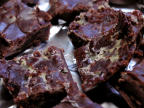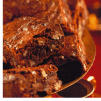Open Fruit, Discover Pure Flavor
 Did you know that 90% of Americans eat turkey on Thanksgiving? That’s a HUGE percentage! I realize that Toothsome Delight’s audience is not quite that extensive, but I’m hoping to convince at least a few of you out there to consume some pomegranate along with your turkey this year.
Did you know that 90% of Americans eat turkey on Thanksgiving? That’s a HUGE percentage! I realize that Toothsome Delight’s audience is not quite that extensive, but I’m hoping to convince at least a few of you out there to consume some pomegranate along with your turkey this year.
Najmieh Batmanglij is the inspiring, powerful woman who opened my eyes to the soul of the pomegranate (at last year’s WOF Conference–and yes folks, it is a soul). As she gave a demonstration on how to appreciate this fruit using only your bare hands and your mouth, the entire audience was brought to tears. Symbolic of health, fertility and rebirth, it is especially appropriate for the day on which we celebrate two cultures overcoming envy and hatred and coming together in the birth of a new nation. As a religiously and culturally important product the pomegranate deserves the utmost respect– so put down your knife and prepare to become one with the fruit.
A Lesson On Becoming One With Your Pomegranate
*Awaken your senses*
Choosing the perfect fruit is all about color and weight. Pick the heaviest, most brilliant and vibrant fruit you can find. You’re looking for deep red-purple skin that isn’t cut or scabbed in any way. Pick the fruits up: feel them, shake them–the heavier they are, the more sugar is in the juice (signaling that they were allowed to ripen properly and are going to be much tastier than prematurely picked pommies).
When you get your pomegranate home and are ready to use it, quiet your mind. Prepare your mental mis en place as you ready yourself to embark on an ancient pomegranate ritual. (I.e., Wash your hands, put on some sitar music and get a bowl for seed collection).
Start by massaging the fruit with both hands, rotating it constantly. Be sensitive but firm. You should hear some subtle popping noises–those are the arils (deep crimson, juice-filled gems) coming away from the membrane. You’re trying to wake the fruit up, so the more popping the better. Just make sure not to pop a hole in the skin. Continue rotating and massaging until the popping ceases–so that when you shake the pom, it feels like a ball full of juice. (This may take several minutes, enjoy it! Be patient, the reward is sweet).
When you’ve thouroughly massaged your pomegranate, bring it to your mouth and make an incision in the side of the fruit with your front teeth. Remember, this is not an apple, you just want to slice deep enough into the skin enough so that you can suck the juice out, there’s no need to take a huge bite out of the pommie. You may want to lean over your bowl so as not to lose any of that delicious nectar; in the olden days pomegranate juice was used as a dye.
The first reward: now go ahead and slurp the juice out! Oh! Sweet, sweet pomegranate juice! When you’ve had your fill, hold the pomegranate over your bowl and wriggle your thumbs into the incision you made earlier. Gently pull the fruit open to reveal the rubies inside! Aren’t they beautiful? Inside those fleshy arils are seeds. This is my favorite part of the pomegranate– the crimson jewels. The outside is soft and juicy while the seed inside pops and is chewy. Oh, Lord. They’re so good.
There is an alternative way to open the pomegranate, but I do not recommend it because you lose the whole sensual experience of the opening along with all that delicious juice. But if you really want to, you can cut the crown off the top and then section the fruit like you would an apple. Hold the sections in a bowl of water and roll the arils out. The seeds will sink to the bottom and everything else will float to the top. You can then strain the membrane from the arils with a colander.
What to do with these seeds now that you’ve got them out of their skin? Eat them of course! Sprinkle them on salad or ice cream. Try cooking them into a pomegranate-cranberry sauce for a more Persian and a way more interesting, Turkey Day garnish. I’ve adapted this recipe from the Pom Wonderful website so it’s less fuss.
Cranagranate Sauce
Ingredients
1 cup Pomegranate juice (from 2-3 poms or from a bottle)
1 cup Water
Zest of 1 Orange
2/3 cup Sugar
1 1/2 cups Cranberries
Arils from 1 Large Pomegranate
Method
1. Put everything except the arils into a pot and BTAB (Bring to a boil).
2. Reduce heat and simmer until sauce is desired consistency (10-20 minutes).
3. Remove from heat and stir in arils. Cool and refrigerate.

 greatly in the past few years and brought brownies to the forefront of the dessert scene. From kids to accredited chefs, Americans country-wide are creating and consuming brownie varietals more quickly than ever before.
greatly in the past few years and brought brownies to the forefront of the dessert scene. From kids to accredited chefs, Americans country-wide are creating and consuming brownie varietals more quickly than ever before.
 handy illustrated instructions.
handy illustrated instructions. There are these old bugs–the volkswagon kind
There are these old bugs–the volkswagon kind